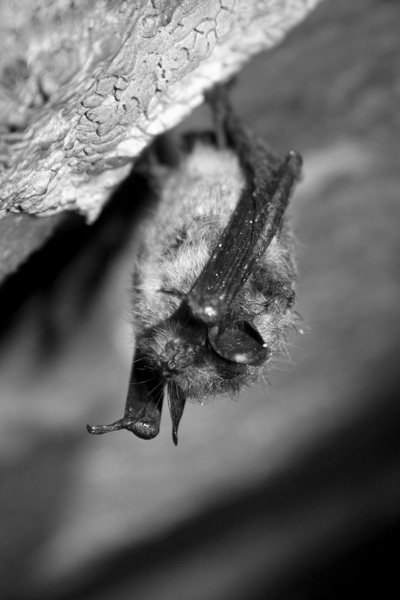News & Issues
New hope for bats
Researchers find improved survival among one species, after long decline
 By EVAN LAWRENCE
By EVAN LAWRENCE
Contributing writer
DORSET, Vt.
Biologists have documented the first hopeful sign that the region’s bat populations may eventually recover from the devastation of white nose syndrome.
The numbers of one species of bat affected by the deadly disease appear to be stabilizing, with some individuals having survived several years of exposure to it, biologists say.
Biologists from New York and Vermont tagged 442 little brown bats last fall as the creatures swarmed outside a cave where they spend the winter on Mount Aeolus in Dorset.
Radio equipment that could read chips in the tags detected 184 bats leaving the cave in April at the right time to end their winter hibernation. Only eight of the tagged bats left the cave during the winter -- behavior typical of bats infected with white nose syndrome.
“The preliminary results from the study show that the tagged bats spent a pretty normal winter,” said Carl Herzog, a wildlife biologist with the New York Department of Environmental Conservation who worked on the project.
That finding is in stark contrast to what biologists witnessed for much of the past decade.
“A few years ago, most bats died of starvation or from leaving the cave too early,” Herzog said. In this study, however, “we saw very little activity before spring.”
Although only 184 of the 442 tagged bats emerged from the Mount Aeolus cave in the spring, Herzog explained that the 250 unaccounted-for bats likely did not wind up wintering at the cave at all. He said bats come together to mate in the fall, just before hibernation. Bats don’t form pair bonds, and they may visit several hibernating sites and mate repeatedly before they settle in for the winter. Most of the missing bats probably hibernated somewhere else, he said.
Alyssa Bennett, a Vermont Department of Fish and Wildlife biologist who took part in the research at Mount Aeolus, said it’s possible some tagged bats could have died deeper in the cave where researchers couldn’t find them. But previous surveys have shown that little brown bats at Aeolus rarely go beyond the cave’s main hall.
On visits every two weeks over the winter, Bennett said, researchers found at least a dozen dead, untagged bats outside the cave, and another half-dozen untagged bats were on the cave floor when they entered in the spring. In any case, after years of 90 percent winter mortality, a survival rate among the tagged bats of at least 43 percent is good news.
Devastating disease
White nose syndrome is caused by a fungus, Pseudogymnoascus destructans, that is native to Eurasia. The fungus thrives at the same temperatures and humidity levels that cave-hibernating bats prefer.
Infected bats develop characteristic white patches on their muzzles, wings and tails, hence the name. The fungus appears to irritate the bats, causing them to wake up repeatedly when they should be deep in hibernation. Exactly how the disease causes death is still under investigation, but a big factor is that the bats use up their winter fat stores prematurely, then starve when they can’t find food.
The disease was unknown in North America until 2006, when dying bats were discovered in the snow outside a cave in Albany County. It has since spread to 25 states and five Canadian provinces, killing an estimated 5.7 million cave-roosting bats.
Numbers of little brown bats, once the most common in the Northeast, have dropped by 90 percent. Other species have seen mortality rates up to 98 percent.
Big brown bats gather in cold, dry buildings where the fungus is less of a threat, but their population in the region is still down by more than 40 percent. Tree-roosting bats, which are solitary and migrate instead of hibernate, aren’t affected.
The disease is not transmissible to humans, although people can spread it when they visit places where bats congregate.
Bats prey on night-flying insects such as mosquitoes, moths and beetles, many of which are important agricultural or forest pests or carriers of disease. It isn’t clear what impact the loss of bats has had on insects.
“Entomologists I’ve talked to say it’s very difficult to draw cause and effect,” Bennett said.
The biggest factor in mosquito numbers, for example, is the presence of standing water for breeding, she said.
Connecting the data
In the summer, female little brown bats form maternity colonies to bear and raise their young. Biologists have tagged females in several maternity colonies in the Champlain Valley and upstate New York and found that the same females are returning year after year.
“There’s a small remnant population still hanging in there,” said Jeremy Coleman, the national white nose syndrome coordinator for the U.S. Fish and Wildlife Service. “It’s maybe 3 to 5 percent of the numbers we used to see -- 20, 30 or 100 in caves that used to have hundreds of thousands.”
Tagging studies at maternity colonies in vacant buildings at Fort Drum, outside Watertown, N.Y., have caught the same female bats six years in a row, which Coleman called “incredible success.”
“We’re trying to connect the bats in the maternity colonies to the hibernacula” to figure out where these bats are spending their winters, Coleman said.
If the bats can be tracked, he said, it might be possible to figure out why they’re surviving.
One of the challenges with little brown bats is that before white nose syndrome arrived, they were so common that no one bothered to study them.
“We don’t know what normal little brown bat behavior is,” Coleman explained. “Their population dynamics and hibernation behavior weren’t understood. We’ve made great strides since white nose syndrome struck.”
Herzog said the improving survival rate among little brown bats, however, may not carry over to other species, whose numbers are continuing to decline. Instead, it appears that some little brown bats are surviving the disease despite being exposed to it.
“It’s not that they don’t have it,” Herzog said. “Every bat we’ve examined is clinically infected, but it’s not killing them. Why, we don’t understand.”
There are several theories. One is that survivors have skin proteins that resist the fungus, Coleman said. Another is that individuals are choosing colder hibernating sites or hibernating in smaller groups, both of which would discourage the fungus.
Biologists in Pennsylvania also are checking out a “fat bat” theory after noticing that bats that weighed more when entering hibernation were more likely to survive until spring.
“There are differences between species,” Coleman said. “Why are some more affected than others? The Virginia big-eared bats are doing remarkably well; their numbers are increasing steadily in caves where other species have been annihilated.”
Whatever the reason, “we hope it’s some trait that’s genetic so it can be passed down,” Coleman said.
More research ahead
The U.S. Fish and Wildlife Service is providing $60,000 to continue research at the Mount Aeolus cave in the coming winter, Bennett said. Custom-made equipment to read the bats’ radio tags wasn’t ready last fall, so researchers couldn’t track how many tagged bats actually entered the cave. This year, they hope to capture that information.
The prospects for disease-resistant bats may be good. Survivors will have less competition for food, roosting and hibernation sites, Coleman said.
But even in the best-case scenario, it would be many years, if ever, before the numbers of all the affected species return to what they were. Bats may live to be more than 20 years old, but females have only one pup per year, and fewer than 70 percent of those survive their first year, Bennett said.
Under normal conditions, about 5 percent of adults die annually. Apart from white nose syndrome, bats continue to face threats from habitat loss, predation and other diseases, Coleman added.
“We probably won’t see complete recovery in our lifetimes,” Bennett said.
What can people do to help bats? The most important is to avoid disturbing hibernating bats, Herzog said.
“Stay out of caves in the winter,” he said. “Waking them up is the whole mechanism of how the disease hurts them.”
The Mount Aeolus cave has a gate designed to keep people out and let bats pass.
“Some bats, like the little brown bat, like well-designed bat houses,” Bennett said, adding that there are plans for these houses available at www.batcon.org, the Web site of Bat Conservation International. Dead and dying trees, with cavities, cracks and peeling bark, provide shelter as well.
“Share the information,” Bennett added. “Bats have gotten a bad rap over the years. When people have a better understanding, it quells their fears, and they become interested in conservation.”
For more information about bats and white nose syndrome, visit www.whitenosesyndrome.org and www.batcon.org.

